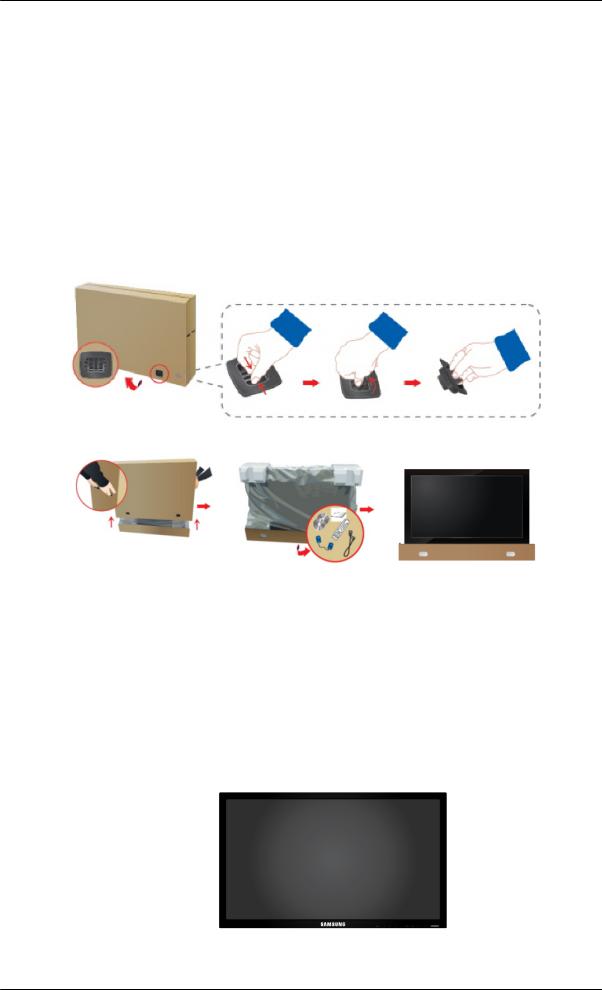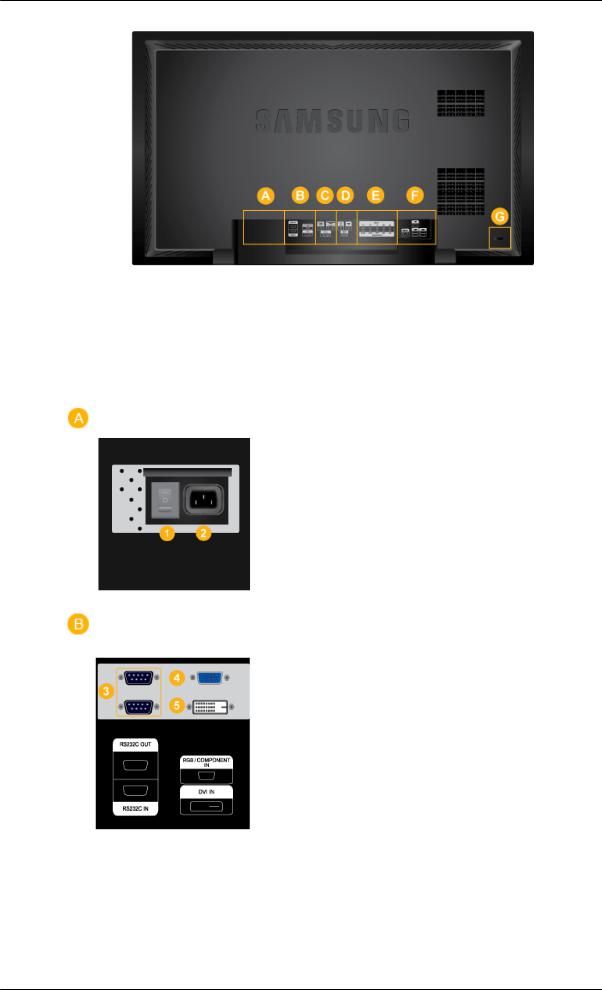Samsung 400DXN-2, 400DX-2, 460DXn-2, 460DX-2 User Manual

LCD DISPLAY
quick start guide
400DX-2, 400DXN-2, 460DX-2, 460DXN-2

Introduction
Package Contents
 Note
Note
Please make sure the following items are included with your LCD Display.
If any items are missing, contact your dealer.
Contact a local dealer to buy optional items.
Checking the Contents of the Package
Remove the lock from the package box, as shown in the figure above.
Lift up the package box by |
Check the contents of the |
Remove the Styrofoam |
holding the grooves on |
package. |
and vinyl cover. |
both sides of the package |
|
|
box. |
|
|
 Note
Note
•After unpacking the package, make sure to check the contents of the package.
•Make sure to keep the package box for transporting the product in the future.
Unpacking
LCD Display

Introduction
Manuals
Quick Setup Guide |
Warranty Card |
User's Guide |
(Not available in all locations)
MagicInfo Software CD,
MagicInfo Manual CD
(Applicable to the DXN-2 model only)
Cables
Power Cord
Others
Remote Control |
Batteries (AAA X 2) |
BNC to RCA Adaptor Jack |
(BP59-00138A) |
(Not available in all loca- |
(Applicable to the DX-2 |
|
tions) |
model only) |
Sold separately |
|
|
D-Sub Cable |
DVI Cable |
LAN Cable |
(Used with DXN-2 model only)

Introduction
Sold separately |
|
|
Wall Mount KIT |
RGB to BNC Cable |
BNC to BNC Cable |
|
|
(Applicable to the DX-2 |
|
|
model only) |
RGB to Component Cable |
Semi Stand KIT |
Your LCD Display
Front
MENU button [MENU]
Opens the on-screen menu and exits from the menu. Also use to exit the OSD menu or return to the previous menu.
Navigate buttons (Up-Down buttons)
Moves from one menu item to another vertically or adjusts selected menu values.
Adjust buttons (Left-Right buttons) /Volume buttons
Moves from one menu item to another horizontally or adjusts selected menu values. When OSD is not on the screen, press the button to adjust volume.
ENTER button [ENTER]
Activates a highlighted menu item.
SOURCE button [SOURCE]
Switches from PC mode to Video mode. Selects the input source that an external device is connected to.

Introduction
[PC] → [DVI] → [AV] → [Component] → [HDMI] → [MagicInfo]  Note
Note
•The BNC mode will not be activated on the DXN-2 model.
•MagicInfo supports the DXN-2 model only.
PIP button
Push the PIP button to turn the PIP screen On / Off.
More than one PIP cannot overlap on screen as BNC and the component use the same terminal.
•PC : DVI / AV / Component / HDMI
•BNC : DVI / AV / HDMI
•DVI / AV : PC / BNC
•Component : PC
•HDMI : PC / BNC
Power button [ ]
]
Use this button for turning the LCD Display on and off.
Brightness Sensor (Optional)
Automatically detects the surrounding brightness it accordingly.
 Note
Note
This function is activated only on the models equipped with an auto brightness sensor.
Power indicator
Shows PowerSaver mode by blinking green
 Note
Note
See PowerSaver described in the manual for further information regarding power saving functions. For energy conservation, turn your LCD Display OFF when it is not needed or when leaving it unattended for long periods.
Remote Control Sensor
Aim the remote control towards this spot on the LCD Display.
Rear
 Note
Note
For detailed information concerning cable connections, refer to Connecting Cables under Setup. The LCD Display 's configuration at the back may vary slightly depending on the LCD Display model.

Introduction
 Note
Note
 Applicable to the DX-2 model only.
Applicable to the DX-2 model only.
 Applicable to the DXN-2 model only.
Applicable to the DXN-2 model only.
 POWER S/W ON [│ ]/OFF [O]
POWER S/W ON [│ ]/OFF [O]
Switches the LCD Display On/Off.
 POWER
POWER
The power cord plugs into the LCD Display and the wall outlet.
 RS232COUT/IN(RS232CSerialPORT)
RS232COUT/IN(RS232CSerialPORT)
MDC(Multiple Display Control) Program Port
 RGB/COMPONENT IN (PC/COMPO-
RGB/COMPONENT IN (PC/COMPO-
NENT Connection Terminal (Input))
•Use a D-Sub Cable (15 pin D-Sub) - PC mode (Analog PC)
•Connect the RGB/COMPONENT IN port on the monitor to the COMPONENT port on the external device using the D-SUB to COMPONENT cable.
•Connect the RGB/COMPONENT IN port on the monitor to the BNC port on the PC using the D-SUB to BNC cable.

Introduction
 DVI IN (PC Video Connection Terminal)
DVI IN (PC Video Connection Terminal)
Use a DVI Cable (DVI-D to DVI-D) - DVI mode (Digital PC)
 DVI/RGB/HDMI AUDIO IN (PC/DVI/
DVI/RGB/HDMI AUDIO IN (PC/DVI/
HDMI Audio Connection Terminal (Input))
AV/COMPONENTAUDIOIN[L-AUDIO-
R]
Connect the port of the DVD, VCR (DVD / DTVSet-TopBox)tothe[L-AUDIO-R]port of the LCD Display.
 DVI OUT
DVI OUT
•Connect a monitor to another monitor through a DVI cable.
•ConnecttheDVIOUTportonthemonitor to the HDMI IN port on the other monitor using the DVI to HDMI cable.
•DVI, HDMI and network signals sent via the DVI OUT port are displayed on the seconddisplaywhichhastheDVIINport.
 Note
Note
Up to 6 Full HD or 10 HD monitors can be connected (May differ depending on the product).
 AV IN [VIDEO]
AV IN [VIDEO]
Connect the [ VIDEO ] terminal of your monitor to the video output terminal of the external device using a VIDEO cable.
 AUDIO OUT
AUDIO OUT
Headphone/External speaker output terminal.
 HDMI IN
HDMI IN
Connect the HDMI terminal at the back of your LCD Display to the HDMI terminal of

Introduction
your digital output device using a HDMI cable.
Up to HDMI cable 1.0 can be supported.
 BNC OUT [R, G, B, H, V] (BNC Terminal (Output))
BNC OUT [R, G, B, H, V] (BNC Terminal (Output))
BNC (Analog PC) Connection: connecting the R, G, B, H, V ports.
The number of LCD Displays that can be connected to the loopout depends on the cables,signalsource,etc.Withcablesorsignal source where there is no degradation, up to 10 LCD Displays can be connected (May not be supported depending on the connected cable).
 Note
Note
(Applicable to the DX-2 model only)
 (BNC/Component Connection Terminal (input))
(BNC/Component Connection Terminal (input))
Duringcomponentinput,pleasecheckspecifications for the input ports below.
[R/Y, G/PB, B/PR, H, V]
•[R/Y] --> Red port input
•[G/PB] --> Green port input
•[B/PB] --> Blue port input
 Note
Note
Applicable to the DX-2 model only.
 RGB OUT
RGB OUT
 Note
Note
Applicable to the DXN-2 model only.
 LAN (LAN Connection Terminal)
LAN (LAN Connection Terminal)
 Note
Note
Applicable to the DXN-2 model only.
 USB1,USB2(USBConnectionTerminal)
USB1,USB2(USBConnectionTerminal)

Introduction
Keyboard / Mouse, Mass Storage Device
Compatible.
 Note
Note
Applicable to the DXN-2 model only.
Kensington Lock
The Kensington Lock is a device used to physically fix the system when using it in a public place. The locking device has to be purchased separately. The appearance and locking method may differ from the illustrationdependingonthemanufacturer.Referto the manual provided with the Kensington Lock for proper use. The locking device has to be purchased separately.
 Note
Note
The location of the Kensington Lock may be different depending on the model.
UsingtheAnti-TheftKensingtonLock
1.Insert the locking device into the Kensington slot on the LCD Display  and turn it in the locking direction
and turn it in the locking direction  .
.
2.Connect the Kensington Lock cable.
3.Fix the Kensington Lock to a desk or a heavy stationary object.
 Note
Note
See Connecting Cables for further information regarding cable connections.
Remote Control
 Note
Note
The performance of the remote control may be affected by a TV or other electronic device operating near the LCD Display , causing a malfunction due to interference with the frequency.
